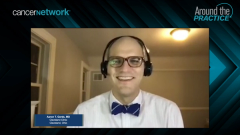
Optimizing Therapy for Patients With Myelofibrosis
Responses to questions by community hematologists/oncologists regarding optimal ways to diagnose and manage patients with myelofibrosis.
Episodes in this series

John Mascarenhas, MD: Maybe we’ll take some of the audience questions that were posed.
Srdan Verstovsek, MD, PhD: I have some I can read. Audience question number 1: What is the value in trending the quantitative JAK2 [Janus kinase 2] burden in patients with myelofibrosis at any time point in the national history of MF [myelofibrosis]?
So basically, measuring the JAK2 a little burden in myelofibrosis spaces over time, what’s the value, if any? Aaron?
Aaron T. Gerds, MD: Thank you for the most controversial question of them all. I think it’s something we have. It’s something we can measure. It’s something we can repeatedly measure very easily. We get a sample of blood, we run a JAK2 analysis, and we love to see the numbers go up or go down but it doesn’t always correlate with things necessarily. Now there is certainly data in ET [essential thrombocythemia] and PV [polycythemia vera]where we see people going into molecular remissions. Maybe we can even stop the therapy that they’re on but I think it’s a little bit tougher in myelofibrosis to understand what changes in allele burden really mean. I think you could postulate that increasing allele burdens are bad but that’s not always the case. We have patients who have again cytopenic myelofibrosis with very low JAK2 allele burdens who have a horrible disease and very short survival. I think that’s still something we need to figure out and quite frankly, I think we just need better biomarkers than just measuring an allele burden. I think there’s a lot more to that story that we’re just not seeing.
Srdan Verstovsek, MD, PhD: Interesting. I think it’s a really controversial topic. Next question, how do you know if therapy is working in a patient that has cytopenic myelofibrosis? Well, I would say the way to assess the benefit is the same but it’s harder to see it because you can’t really treat it very well. John, what do you think?
John Mascarenhas, MD: I agree. I think the goals often remain the same in terms of addressing spleen and symptom and perhaps ameliorating the cytopenia, so I think success in the cytopenic MF patient would be much the same as of the proliferative patient in terms of addressing their symptom and spleen burden. But there may be an added goal of trying to at least not worsen the cytopenias that already exist that are disease driven and perhaps in some cases, improve it. And I think it’s worth pointing out that in, PERSIST-1there was a 25% transfusion independence rate with the pacritinib. So there is the opportunity in some of these patients, a subset of patients at least, to alleviate some of the transfusional burden that comes along with the cytopenic MF profile. Although you’re unlikely to normalize a platelet count, I think with treatments like pacritinib, for example, you’re able to deliver that JAK inhibition without making it worse. And sometimes you do see slight improvements in platelet counts so I think it’s a mixed bag. It really depends on what you’re trying to achieve with any given patient.
Srdan Verstovsek, MD, PhD: The next question is about the use of erythropoietin-stimulating agents in anemic myelofibrosis patients along with the JAK [Janus kinase] inhibitors. Is this common? Do you do it? Raajit?
Raajit K. Rampal, MD, PhD: Great question. That’s pretty common clinical practice. I think it depends of course on the patient’s baseline EPO [erythropoietin] level and one has to be careful about measuring that after starting a JAK inhibitor. It certainly can have clinical utility. It’s something that can be easily done in everyday practice, and I think there is some bright spots in the future based on Aaron’s data with Liz Patterson, which clearly shows in combination with ruxolitinib [Jakafi] the best efficacy it has in terms of improving anemia. So yes, absolutely.
Srdan Verstovsek, MD, PhD: And 1 more question on the dose reduction of ruxolitinib in patients with low platelets. I think it’s related to that last case when the platelets go below 50. Do you continue? What do you expect with the 5 milligrams twice a day of ruxolitinib?
Not much, but you can have some. Aaron, what do you say?
Aaron T. Gerds, MD: I think when you only have 1 hammer, you try to hit everything with it and for so long we’ve had just ruxolitinib and we’ve done all these things. We’ve done low-dose ruxolitinib studies. There’s a pilot study that started off with 5 milligrams every other day in cytopenic patients. Of course, there’s a dose-response curve. We just don’t see the spleen and symptom improvement in patients on these ultra-low doses of ruxolitinib. I think John really went into and eloquently spoke about the different pathways that pacritinib will hit. I’m just a simple country doctor, but when I see the data with pacritinib and how many people have measurable improvement compared to those on low-dose ruxolitinib I think it’s a treatment that’s really warranted. And again, as you said Srdan, something that we really welcome in the field, so I think the evidence speaks for itself there. Reducing ruxolitinib, it’s tricky. It’s just not the same as proliferative myelofibrosis where you can give the full doses. It’s just not close.
John Mascarenhas, MD: I’ll ask you guys a question that comes up or at least I’ve thought about. Obviously, there is no perfect world but in a perfect world or next year, let’s say, where there are multiple JAK inhibitors available, such as momelotinib and pacritinib, if you’re faced with a new MF patient that has both transfusion-dependent anemia and thrombocytopenia, how do you make the decision there in terms of what you move to? You may avoid ruxolitinib and fedratinib [Inrebic] in such a patient but do you go for momelotinib for the anemia response potential or do you go for pacritinib to maximize your JAK inhibition and minimize your myelosuppression? Raajit, maybe you want to take a stab at that one.
Raajit K. Rampal, MD, PhD: Thank you for that easy question. It’s a complicated thing and we’re fortunate that hopefully, we’re going to have options to actually address this really difficult clinical problem. I think it may depend ultimately on magnitude. For example, thrombocytopenia. Certainly, in the reanalysis data from the simplified trials, there was a subset of patients who were thrombocytopenic. Not of course profoundly as with the pacritinib studies but those patients still had benefits in terms of even immune benefits. I think it’s not going to go into discrete boxes necessarily. There’s going to be overlap here. It’s going to be a clinical judgment. It’s partially also going to depend on the drug’s toxicity profile and the patient’s comorbidities. But I would think of it more as a spectrum rather than discrete boxes that 1 drug fits here and 1 drug fits there.
Aaron T. Gerds, MD: I almost see a battleground developing because clearly the simplified trials include anyone with platelets counts less than 50,000. All the trials included everyone with platelets counts more than 100,000 so there’s this battleground brewing of the 50 to 100s. Do you think about pacritinib? Do you think about momelotinib? Do you think about fedratinib? What’s going to be your best JAK inhibitor? I think in this perfect world that you imagine John, I would love to do a randomized trial of patients with counts 50 to 100 of all the JAK inhibitors to really see but I know that’s not realistic. Like Raajit said, thinking about side effects like neuropathies or the GI [gastrointestinal] side effects might steer you one way or the other.
Srdan Verstovsek, MD, PhD: There are a few more questions here. I’ll take this one. It says: Do you use a luspatercept for MF-related anemia with or without the JAK inhibitors?
It’s a good question because the luspatercept on the market is for some patients with myelodysplasticsyndrome but it’s not that easy to give to MF [patients]. In fact, it’s not proven. It is in a phase 3 study for possible approval in MF so I have not really used it. I would really only use it alone in people who are suffering from anemia specifically or in combination with JAK inhibitors but it really has to be proven that it’s valuable. And we have to wait for the phase 3 study to mature. I think that’s something we probably all agree on.
The next question is tricky. I will not pick on anybody, but I don’t really know the answer. Does JAKARTA-2 help with alleviating bruising or platelet dysfunction in patients with MF? I’m not really aware of any effect on the activity of the platelets at all, right?
Raajit K. Rampal, MD, PhD: Yes.
Srdan Verstovsek, MD, PhD: The next question is: What’s the role of radiation or splenectomy now that we have JAK inhibitors? Do you do that or those after failing JAK inhibitors? Is there still a role for radiation or splenectomy? I think we do have that as an option but not in too many patients.
John Mascarenhas, MD: Yes. I think it’s used much less frequently today than when it was used before 2011. I do still have occasional patients. We have 1 next week that is going to go for splenectomy. That patient really has a very prolific disease that has outpaced maximum JAK inhibition and actually HMA [hypomethylating agents] therapy. These patients do exist. She’s more spleen than she is person at this point and clearly needs relief. Ideally, she’s going to a transplant. To optimize that outcome, we’re actually going to have her move on to get splenectomy but I would say that those are the infrequent cases these days.
Srdan Verstovsek, MD, PhD: No more questions that I see. Thank you, John.
John Mascarenhas, MD: If there are no more questions, we’ll end this program. I want to really sincerely thank Drs Gerds, Rampal, and Verstovsek for joining us in this lively discussion on MF brought to you by Cancer Network®. Thank you to our viewing audience. We hope you found this interactive discussion to be informative and beneficial to your clinical practice. Thanks for joining us.
Transcript edited for clarity.
Newsletter
Stay up to date on recent advances in the multidisciplinary approach to cancer.






